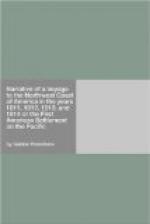The object of Mr. Reed’s journey being defeated by the loss of his papers, he repaired, with the other gentlemen, to Mr. David Stuart’s trading post, at Okenakan, whence they had all set out, in the beginning of May, to return to Astoria. Coming down the river, they fell in with Mr. R. Crooks, and a man named John Day. It was observed in the preceding chapter that Mr. Crooks remained with five men among some Indians who were there termed friendly: but this gentleman and his companion were the only members of that party who ever reached the establishment: and they too arrived in a most pitiable condition, the savages having stripped them of everything, leaving them but some bits of deerskin to cover their nakedness.
On the 12th, the schooner, which had been sent down the river to the Beaver’s anchorage, returned with a cargo (being the stores intended for Astoria), and the following passengers: to wit, Messrs. B. Clapp, J.C. Halsey, C.A. Nichols, and R. Cox, clerks; five Canadians, seven Americans (all mechanics), and a dozen Sandwich-islanders for the service of the establishment. The captain of the Beaver sounded the channel diligently for several days; but finding it scarcely deep enough for so large a vessel, he was unwilling to bring her up to Astoria. It was necessary, in consequence, to use the schooner as a lighter in discharging the ship, and this tedious operation occupied us during the balance of this month and a part of June.
Captain Sowles and Mr. Clarke confirmed the report of the destruction of the Tonquin; they had learned it at Owhyhee, by means of a letter which a certain Captain Ebbetts, in the employ of Mr. Astor, had left there. It was nevertheless resolved that Mr. Hunt should embark upon the “Beaver,” to carry out the plan of an exact commercial survey of the coast, which Mr. M’Kay had been sent to accomplish, and in particular to visit for that purpose the Russian establishments at Chitka sound.
The necessary papers having been prepared anew, and being now ready to expedite, were confided to Mr. R. Stuart, who was to cross the continent in company with Messrs. Crooks and R. M’Lellan, partners dissatisfied with the enterprise, and who had made up their minds to return to the United States. Mr. Clark, accompanied by Messrs. Pillet, Donald, M’Lellan, Farnham and Cox, was fitted out at the same time, with a considerable assortment of merchandise, to form a new establishment on the Spokan or




